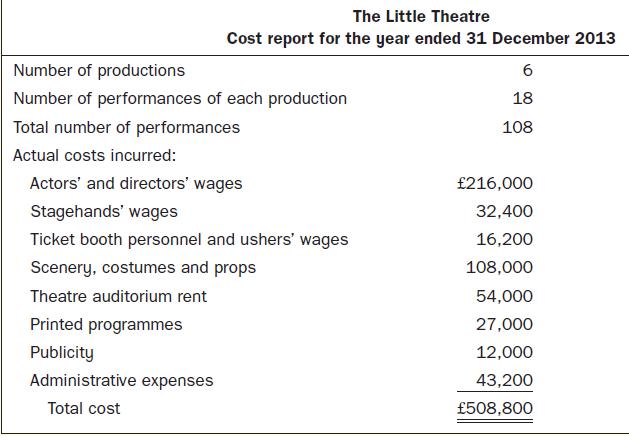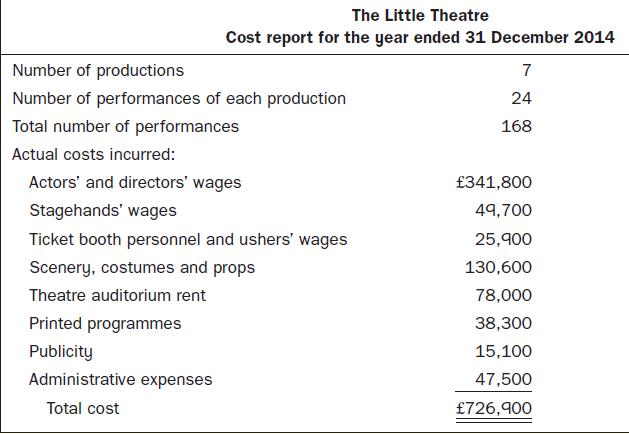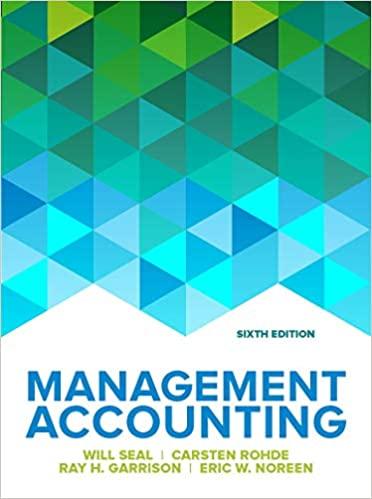The Little Theatre is a non-profit organization devoted to staging theatre productions of plays for children in
Question:
The Little Theatre is a non-profit organization devoted to staging theatre productions of plays for children in Manchester. The theatre has a very small full-time professional administrative staff. Through a special arrangement with the actors’ union, actors and directors rehearse without pay and are paid only for actual performances. The costs of 2013’s operations appear below. During 2013, The Little Theatre had six different productions, each of which was performed 18 times. For example, one of the productions was Peter the Rabbit, which had the usual six-week run with three performances each weekend.
Some of the costs vary with the number of productions, some with the number of performances, and some are relatively fixed and depend on neither the number of productions nor the number of performances. The costs of scenery, costumes and props, and of publicity vary with the number of productions. It does not make any difference how many times Peter the Rabbit is performed, the cost of the scenery is the same. Likewise, the cost of publicizing a play with posters and radio commercials is the same whether there are 10, 20 or 30 performances of the play. On the other hand, the wages of the actors, directors, stagehands, ticket booth personnel and ushers vary with the number of performances. The greater the number of performances, the higher the wage costs will be. Similarly, the costs of renting the auditorium and printing the programmes will vary with the number of performances. Administrative expenses are more difficult to pin down, but the best estimate is that approximately 75% of these costs are fixed, 15% depend on the number of productions staged, and the remaining 10% depend on the number of performances. At the end of 2013, the board of directors of the theatre authorized expanding the theatre’s programme in 2014 to seven productions, with 24 performances each. Not surprisingly, actual costs for 2014 were considerably higher than the costs for 2013. (Grants from donors and ticket sales were also correspondingly higher.) Data concerning 2014’s operations are as follows:
Even though many of the costs above may be considered direct costs rather than overhead, the flexible budget approach covered in the chapter can still be used to evaluate how well these costs are controlled. The principles are the same whether a cost is a direct cost or is overhead.
Required
1. Use the actual results from 2013 to estimate the cost formulas for the flexible budget for The Little Theatre. Keep in mind that the theatre has two measures of activity – the number of productions and the number of performances.
2. Prepare a performance report for 2014 using the flexible budget approach and both measures of activity. Assume there was no inflation. (Note: To evaluate administrative expenses, first determine the flexible budget amounts for the three elements of administrative expenses. Then compare the total of the three
elements to the actual administrative expense of £47,500.)
3. If you were on the board of directors of the theatre, would you be pleased with how well costs were controlled during 2014? Why or why not?
4. The cost formulas provide figures for the average cost per production and average cost per performance. How accurate do you think these figures would be for predicting the cost of a new production or of an additional performance of a particular production?
Step by Step Answer:

Management Accounting
ISBN: 9780077185534
6th Edition
Authors: Will Seal, Carsten Rohde, Ray Garrison, Eric Noreen





